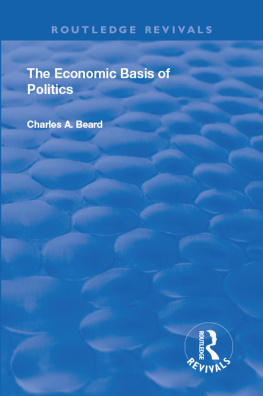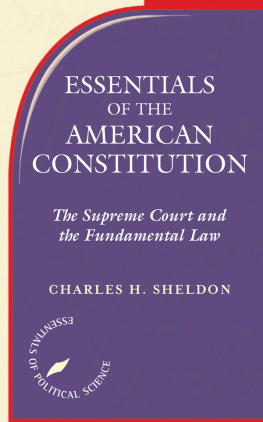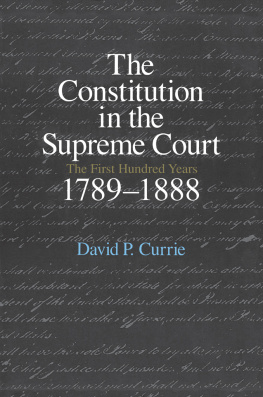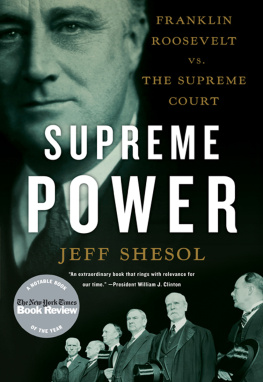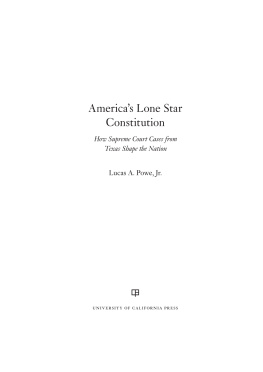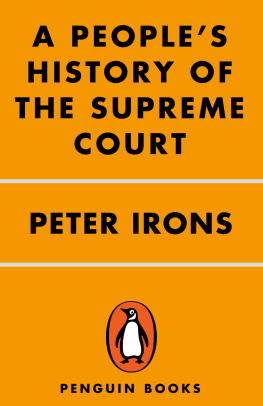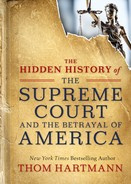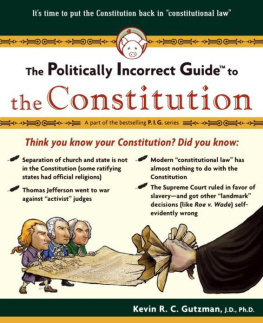Bibliographical Note
This Dover edition, first published in 2006, is a republication of the work originally published in the Classics in History Series by Prentice-Hall, Inc., Englewood Cliffs, N.J., in 1962. The 1962 edition, in turn, was a republication, with an introduction and bibliographies by Alan F. Westin, of the work first published by The Macmillan Company, New York, in 1912. The original Editors Note and the two biographical paragraphs printed at the beginning of the 1962 edition have been omitted in the present volume.
Library of Congress Cataloging-in-Publication Data
Beard, Charles Austin, 18741948.
The Supreme Court and the constitution / Charles A. Beard ; introduction and bibliographies by Alan F. Westin.Dover ed. p. cm.
Originally published: Englewood Cliffs, N.J. : Prentice-Hall, 1962, in series: Classics in history series.
Includes bibliographies.
9780486149615
1. United States. Supreme Court. 2. Judicial reviewUnited States. 3. Constitutional historyUnited States. I. Title.
KF4575.B39 2006
347.7326dc22
2005054771
Manufactured in the United States of America
Dover Publications, Inc., 31 East 2nd Street, Mineola, N.Y. 11501
Introduction
Charles Beard and American Debate Over Judicial Review, 1790-1961
Seventeen decades and fourteen Chief Justices after the adoption of the Federal Constitution, why should anyone still debate whether the Framers intended the Supreme Court to pass on the constitutionality of Congressional legislation? in terms of parsing the records of the Convention and the text of the Constitution itself, putting these into the context of colonial and republican America, and collecting the memoirs and correspondence of the day surely, the job has been done by now and the issue must be considered settled by all except the hopelessly antiquarian.
Such was the view taken, for example, by Professor Felix Frankfurter as long ago as 1924. Dismayed by public charges that the Supreme Court had usurped the power of judicial review, Frankfurter attributed the persistence of this talk to a lack of historical scholarship, combined with fierce prepossessions... One would suppose that, at least, after the publication of Beard, The Supreme Court and the Constitution , there would be an end to this empty controversy.
Charles Beard shared this view of his 1912 study. in the introduction to a re-issue of the work in 1938, he announced firmly:
For practical purposes, [my] book settled the controversy... The ghost of usurpation was fairly laid. Whatever controversies may arise in the future over the exercise of judicial power, it is not likely that the historic right of the Supreme Court to pass upon acts of Congress will again be seriously challenged.
Despite Beards prophecy, the ghost of usurpation has been clanking its chains through legislative chambers, historical meetings, and publishing houses for many a decade since 1912. Several dozen books and perhaps a hundred articles have persisted in treating this as still a debatable proposition, and not all of the commentators can be dismissed as incompetents or outraged partisans deprived of reason.
to probe the reasons for this continuing debate and to assess the relation of Beards study to it, this introductory essay has been divided into four sections. Part I summarizes, in brief fashion, the classic lines of debate over the Supreme Courts power to review acts of Congress. Part II examines critically the sources of conflict and debate over this judicial authority. Part III surveys the literature on the Framers intention as to judicial review of Congressional measures and analyzes certain major periods into which this literature falls. Part IV presents the basic criticisms which have been leveled against the Beard thesis. in a final coda, the essay suggests why the debate over judicial review will never be settled, and why this continued argument should be a source of satisfaction rather than one of concern for a free society.
I. The Classic Lines of Debate Over Judicial Review of Legislation
Before exploring why the debate over judicial review of legislation has continued with such vitality, it is useful to set out the classic assumptions and disputed positions in the controversy. The goal at this point is not to analyze these but only to catalogue them for future reference in this essay.
The pivot on which the entire debate revolves is that the Framers did not state, unequivocally and in a way which would foreclose the argument for all reasonable men reading the Constitution, that the Supreme Court had the power to review Congressional measures and hold them invalid if the Justices thought them unconstitutional. The situation resembles those of the Presidents inherent powers to act as chief executive or the Congress power to spend for the general welfare. in all three, the Framers created an appearance of authority and a description of it in vague terms, but did not draft with sufficient precision to resolve serious ambiguities. Time and the development of our political system have made these provisions central to American constitutional debate, but the Framers spoke only once on these subjects and no constitutional amendments have been passed dealing with judicial review, inherent presidential powers, or spending for the general welfare. The result is that the debate has proceeded at the level of original intention.
Coupled with this fact is the absence of comprehensive records of the Constitutional Convention to rely on for indications of intention. No transcript was taken at Philadelphia. We have the continuous notes of only one participant, James Madison, and meager, scattered notes from a few others. It is not too much to say that Madisons notes have become almost as disputed a written record as the text of the Constitution itself. Since the proceedings were secret, there is no newspaper coverage of the Convention, as there is for leading Congressional debates of the young Republic.
When the language of the Constitution is disputed, as here, there is a variety of criteria which can be used by the courts and by those speaking and writing about the issue as part of our constitutional politics. At least five such approaches can be identified. First, there is strict textual or word analysis, taking what the legislators put down on paper, defining it in dictionary fashion, and refusing to go beyond the words. The assumption of the textual school is that courts and executives should not re-write the Constitution; where ambiguities arise, the means of resolving them is constitutional amendment. A second approach is contextual analysis. Here, the analyst considers not only the text but also the section of the Constitution in which it appears, as well as the document as a whole, to map the environments of meaning in which the Framers placed the disputed clauses. Strictly textual construction, say the contextualists, robs words of their roots in the interacting scheme of government which the Framers assembled to write and which the nation ratified. A third technique adds the drafting process to the net of analysis. Here the analyst studies the progress of the clause from its earliest Convention draft (and even its history as an idea or in other laws or jurisdictions before it reached the Convention), through committees and general debate, through amendments and final stylistic changes, to the final language. Words, in the view of the drafting process analysts, mean more when one examines what fell by the wayside, what was deliberately rejected, and what was heartily approved. A fourth technique might be called developmental analysis. It adds to the others a consideration of the accretions of meaning which the disputed clause has acquired from the time of its enactment to the time of analysis, based upon governmental practices involving the power in question, court interpretations, and changed economic and political conditions. The argument for adding developmental factors is that, as the years advance since the original writing, increasingly broad constructions are needed to keep the purposes of the Framers in tune with new realities. Finally, there is a fifth standard, one which is rarely supported openly but is as real as rock nevertheless. I would call this institutional analysis. in the case of the Supreme Court, as guardian of constitutional construction (including construction of its own powers), this technique has the Justices manipulating the four above criteria in light of the values of society (as the Justices see them), particularly the values of consistency, predictability, and the primacy of the judiciary. Not all Justices would attach this institutional perspective, but a majority of the Court since Marshalls day has usually done so.



